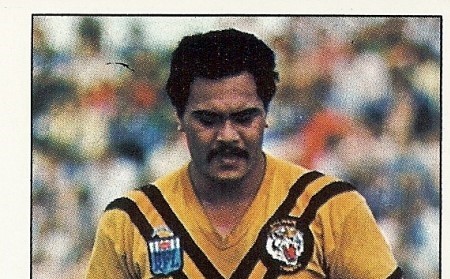International Heroes: Olsen Filipaina
Representing your country at Test level is about rising to the challenge. And few players in the history of the game have met that challenge like New Zealand’s Olsen Filipaina.
A product of the East Managere Hawks in Auckland, Filipaina was a strapping centre/five eighth – as rugged as any backline player to strap on a boot – who was first selected to wear a Kiwi jumper in 1977.
Although he would go on to play 28 tests in a decade representing his country, he is best remembered for outstanding performances for the Kiwis against Australia in 1985 – after being selected directly from the NSWRL reserve grade competition.
Following impressive performances against the Aussies in a three Test series in 1978 that had brought him to the attention of the rugby league public on the other side of “The Ditch”, Filipaina had come to Australia to join the Balmain Tigers in 1980.
But the heavy-set son of a Samoan heavyweight boxer struggled with the fitness demands of week-in, week-out football in and was unable to provide a consistent impact in the top grade.
The story was completely different, however, when Filipaina was asked to pull on the black and white jersey. His ability to rise to the occasion was without peer, the big main able to produce breathtakingly tough football, in both attack and defence.
It was the ’85 series in which Filipaina made an indelible mark for the Kiwis. He was playing reserve grade for the Roosters that year (he only managed eight first grade games that season) when he was called into the New Zealand side to go head-to-head with “King” Wally Lewis, the most lauded figure in the game at that time.
Read more: New Zealand Rugby League’s Greatest Players
What looked like a mismatch on paper was turned on its head. Filipaina didn’t just cope with his role against the game’s biggest name. He played like a man possessed, his driving in-your-face defence giving Lewis little chance to weave his magic.
On the back of Filipaina’s performance the Kiwis almost came away with a shock win at Brisbane’s Lang Park in a hard fought first Test that is also remembered for a sideline brawl between Kevin Tamati and Greg Dowling. In the end Australia claimed a 26-20 victory, but despite the result Filipaina claimed man-of-the-match honours.
Filipaina was outstanding again – making Lewis look second rate – as the Kiwis suffered a heartbreaking last minute 10-6 loss in the second Test. Filipaina later described it as the best personal performance of his career.
New Zealand – with Filipaina again featuring prominently – took the third Test 18-0 and the big five-eight was named man of the series.
Filipaina was again chosen for the Kiwis in 1986, this time from North Sydney’s lower grade side. It would prove to be his last year in the New Zealand national side, although his last rep game was as captain of Western Samoa two years later.
How Filipaina was able to lift his performances so dramatically has become the stuff of international rugby league legend.
I was like a bull – you wave a red flag in front of a bull and it goes mental. You wave an Aussie jersey in front of me and I’m going to do the same thing.
Playing for the Kiwis …. we just had this camaraderie and whenever we got together everything just clicked. It didn’t matter how well you were going in your own football, when we came together to play against the world’s best we just pulled out all stops to try and beat them.
It just used to bring the best out in me. It’s about the pride of playing for your country, and it’s something I always used to look forward to.
The records show Filipaina scored six tries and 44 goals for the Kiwis – those 108 points still place him seventh on New Zealand’s all-time point scorer’s list and certainly among rugby league’s greatest international heroes.
Who are your favourite international rugby league heroes? Who would you like to see us profile next?












If my memory serves me correctly Olsen Filipaina played for quite a few years after he finished in the ARL, including time in country / regional football. Do you have any info on that? Cheers.